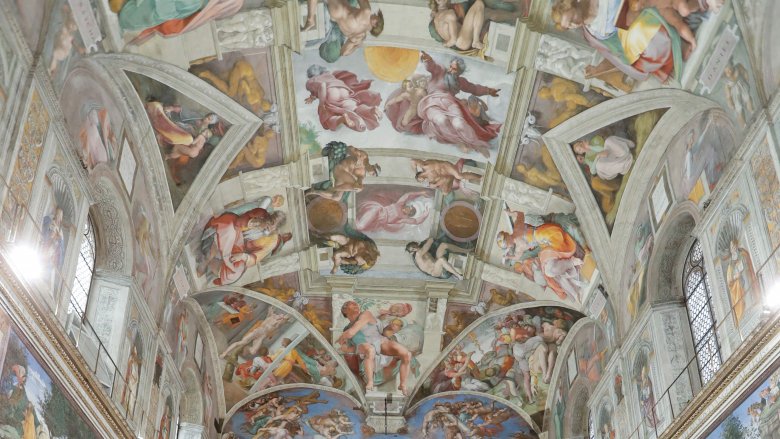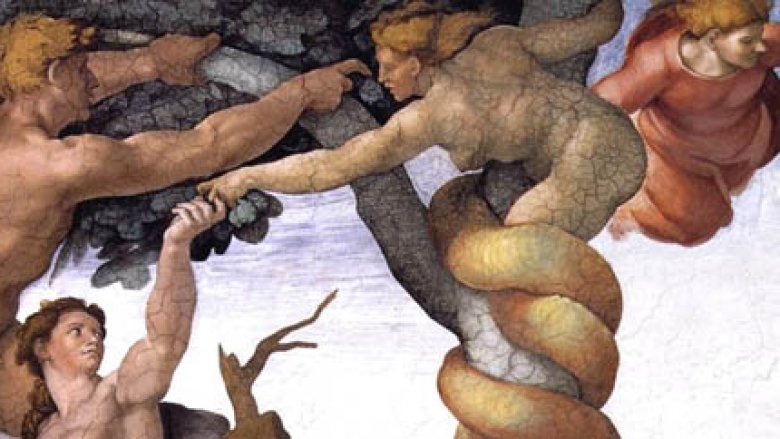The Detail In Michelangelo's Sistine Chapel Everyone Missed
The Sistine Chapel is one of the most iconic buildings in the world, decorated by the work of the most brilliant artists of the Renaissance period, including Rosselli, Botticelli, and, of course, Michelangelo. As LiveScience notes, Michelangelo did two different commissions in the chapel, working on the ceiling from 1508 to 1512 for Pope Julius II, and on the Last Judgement altar fresco from 1536 to 1541. That was at the behest of Pope Clement VII, and the artist was, at the time, in his 60s.
Even though he was presumably laboring under the watchful eye of the clergy, Michelangelo — who, it must be said, didn't actually want to be painting the Sistine Chapel in the first place — managed to hide some ridiculous details in his work, all right in plain sight.
Part of the ceiling tells the story of Adam and Eve, and for a long time, few people noticed that the section depicting the temptation doesn't quite sync with Christian doctrine. The tree, as Atlas Obscura notes, is a fig tree, making the forbidden fruit also a fig.
That's actually a huge deal, and here's why. The Bible, says NPR, never actually defines what the forbidden fruit was. It's just "the fruit," but today, literally everyone thinks it's an apple. Why? Because a fourth-century scholar thought puns were hilarious.
That scholar was Jerome, and he was the one Pope Damasus tasked with translating the Hebrew Bible into Latin. That Hebrew Bible used the word "peri" to describe the forbidden bit of goodness Eve bit into, and that's just a generic term meaning any sort of fruit. When Jerome translated it, he saw an opportunity to write in what he and his sense of humor saw as an excellent pun. He used the Latin word "malus," which translates as both "evil" and "apple." Hilarious, right?
English literature professor Robert Appelbaum of Uppsala University notes that it's more complicated than that, and any "fleshy, seed-bearing fruit" could technically be considered a type of malus. It's just the best translation was an apple and the idea of an apple was firmly cemented then reinforced by epic works from the likes of Albrecht Durer and Milton.
So, why didn't Michelangelo get with the program?
The idea of the apple had been firmly entrenched in Christian mythos, but Jewish traditions say something completely different.
According to Chabad, Jewish sages wrote that the forbidden fruit went unspecified in the original texts because of a fear people would ultimately refuse to eat the fruit that brought about the downfall of man. Legit. They do, however, have some ideas on just what the fruit was based on textual clues, and one of the suggestions supported by a very intriguing argument is a fig. Those who weigh in on the fig's side say it's notable when Adam and Eve realize they're naked and cover themselves with fig leaves. Not only is there clearly a fig tree right there, but scholars write, "By that with which they were made low they were rectified."
And there's a certain amount of beauty to that idea. There are other suggestions, too, including grapes (because Noah first planted grapes in an attempt to atone for mankind's sin), and even wheat. Wheat isn't a fruit, according to some naysayers, but wheat may not have always grown in the form it does today. Supposedly, trees were originally meant to bear loaves of bread in the same way they bear fruit, but after Eve's massive misstep, the fruits of the tree were reduced to grains that required labor to produce the fruit. Also, a very neat idea. Bread trees would be quite popular.
And that loops back around to Michelangelo. It's long been accepted he wasn't above adding a little controversy (like the nude men in the corners of his masterpiece) and that he snuck in some Renaissance-era Easter eggs (like using his own image for Saint Bartholomew's flayed skin and the severed head of Holofernes). Did he also include a whole bunch of Jewish imagery? Rabbi Benjamin Blech, an associate professor of Talmud at Yeshiva University thinks so.
Rabbi Blech wrote The Sistine Secrets: Unlocking the Codes in Michelangelo's Defiant Masterpiece on the clues he found scattered throughout the work, and the presence of Adam and Eve's fig tree is one of the big clues to Jewish symbolism hidden all over the pope's ceiling. He says some of the figures are also positioned in the shape of Hebrew letters, which have symbolic meaning in the esoteric Kabbalah tradition. For example, the figures of David and Goliath resemble the Hebrew letter gimel, which can represent strength.
Did Michelangelo, as Rabbi Blech suggests, paint the Sistine Chapel to be a "bridge" between the Roman Catholic world and the Jewish one? If so, well played, Michelangelo.

